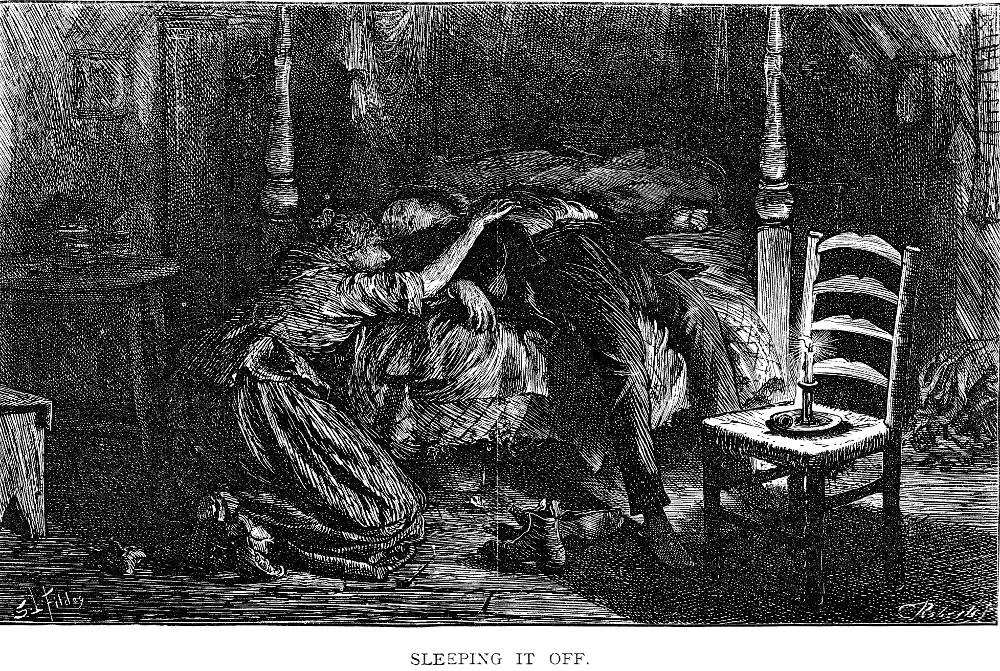He lies a log upon the bed.
Harold Hume Piffard
circa 1900
12 cm high by 7.7 cm wide (4 ⅝ by 3 inches)
Charles Dickens's The Mystery of Edwin Drood, facing p. 288.
Scanned image and text by Philip V. Allingham.
[Victorian Web Home —> Visual Arts —> Illustration —> Charles Dickens —> Harold Hume Piffard —> Mystery of Edwin Drood —> Next]
He lies a log upon the bed.
Harold Hume Piffard
circa 1900
12 cm high by 7.7 cm wide (4 ⅝ by 3 inches)
Charles Dickens's The Mystery of Edwin Drood, facing p. 288.
Scanned image and text by Philip V. Allingham.
[You may use this image without prior permission for any scholarly or educational purpose as long as you (1) credit the person who scanned the image and (2) link your document to this URL in a web document or cite the Victorian Web in a print one.]
He lies a log upon the bed. — Harold Hume Piffard's fifth lithograph for Charles Dickens's The Mystery of Edwin Drood in the Collins Pocket Edition, referencing page 322. [Click on the image to enlarge it.]
“Yes, deary. I’m listening.”
“Time and place are both at hand.”
He is on his feet, speaking in a whisper, and as if in the dark.
“Time, place, and fellow-traveller,” she suggests, adopting his tone, and holding him softly by the arm.
“How could the time be at hand unless the fellow-traveller was? Hush! The journey’s made. It’s over.”
“So soon?”
“That’s what I said to you. So soon. Wait a little. This is a vision. I shall sleep it off. It has been too short and easy. I must have a better vision than this; this is the poorest of all. No struggle, no consciousness of peril, no entreaty — and yet I never saw that before.” With a start.
“Saw what, deary?”
“Look at it! Look what a poor, mean, miserable thing it is! That must be real. It’s over.”
He has accompanied this incoherence with some wild unmeaning gestures; but they trail off into the progressive inaction of stupor, and he lies a log upon the bed. [Chapter XXIII, "The Dawn Again," 322]
The scene now shifts to London, where a number of the Cloisterham characters, including Rosa Bud, have already gone. John Jasper now takes a leave-of-absence from his duties at the cathedral. He checks in, then leaves his luggage at the new railway hotel in Central London, behind Aldersgate Street, near the General Post Office. Leaving this respectable commercial district behind, the choir-master wanders eastward, to the shabby court where Princess Puffer runs an opium den. However, Piffard provides no background details, and focuses instead upon the handsome form and features of the unconscious musician, and on the darkened image and ominous shadow of the opium-dealer. John Jasper has been desperate for a fix as only the Princess can mix it in the bowl of the pipe. This, then, is the opium-induced journey he makes into his own subconscious, and into oblivion, as if trying to escape some terrible memory. The plot will shortly thicken when Princess Puffer follows Jasper back to Cloisterham, and learns his identity.


Left: Luke Fildes's earlier illustration emphasizes the debilitating effects of jasper's opium addition in Sleeping It Off (Chapter XXII). Right: Gustav Doreé's Opium Smoking — The Lascar's Room in "Edwin Drood" (1872).
When Dickens began writing Drood in early 1870, such opium dens as Princess Puffer's were not merely limited to the Treaty Ports of contemporary China, for two entrepreneurs were driving a thriving trade in both Whitechapel and Shadwell Basin. One of these Charles Dickens almost certainly visited in writing the novel, and he probably had read about opium-smoking in an article in London Society in 1868 and "In An Opium-Den" in The Ragged School Union Magazine that same year.
Cohen, Jane R. "Chapter 18: Luke Fildes." Charles Dickens and His Original Illustrators. Columbus: Ohio State U. P., 1980. Pp. 221-234.
Dickens, Charles. The Mystery of Edwin Drood and Other Stories. Illustrated by Sir Luke Fildes, R. A. London: Chapman and Hall Limited, 193, Piccadilly. 1880.
Dickens, Charles. The Mystery of Edwin Drood and Other Stories, illustrated by Harold Hume Piffard. London & Glasgow: Collins' Clear-Type Press, circa 1904.
Created 2 July 2022
